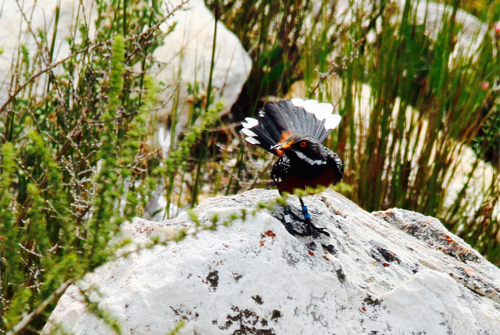Rockjumpers and Climate Change in the Fynbos
By Krista N. Oswald1, Alan T.K. Lee2, Susan J. Cunningham2, and Ben Smit1
The Fynbos biome in south-western South Africa is a global biodiversity hotspot vulnerable to climate change (Kruger and Sekele 2013). Of the 6 Fynbos-endemic passerines, Cape rockjumpers (Chaetops frenatus) are most vulnerable to increases in temperature, with rockjumper population declines strongly correlated with areas experiencing the greatest warming (Milne et al. 2015). The same study also found rockjumpers to be an outlier when comparing heat thresholds of the 6 Fynbos-endemics alongside 6 non-endemics of the same reserve in South Africa, with rockjumpers performing poorly in comparison. Range modelling suggests rockjumpers are climate limited in their habitat distribution (Lee and Barnard 2016), and this study was instrumental in altering their status with BirdLife South Africa, where they are now labelled “near threatened” (Taylor et al. 2015). Rockjumpers occupy high mountain habitat in the Cape Fold Belt, extending from just north of the Cape Peninsula in the Western Cape to near Port Elizabeth in the Eastern Cape. Unfortunately, suitable habitat preferred by this species is predicted to decrease with increasing temperatures, and they lack opportunity to move to cooler regions should their current habitat become unsuitable (Lee and Barnard 2016).
Our recent study on rockjumper seasonal physiology showed that they have limited capacity to cope with both cold and hot temperature extremes (Oswald, 2016), suggesting a physiological reason for their population declines. To cope with cold in winter, these birds increase their metabolic heat production and lower their thermal conductance to conserve energy, although this increase was not as substantial as was expected for a ~ 50 g bird when compared to a global data set (McKechnie et al. 2015). Lower metabolic heat production combined with decreased thermal conductance confers substantial energy savings in winter. Rockjumpers had higher elevations in their metabolic heat production alongside increases in evaporative heat loss, denoting higher rates of heat production and lower heat thresholds in summer compared to winter. They breed from beginning of August through December (Holmes et al. 2002), and the elevated metabolism in summer may be related to breeding. It also suggests that physiological costs associated with increasing temperatures may place stress on their breeding behaviour and success.
 |
|
A male Cape rockjumper. Photo credit: K. Oswald. |
We examined rockjumper behaviour (e.g. microsite usage and time spent foraging) in relation to temperature. There seems to be a link between physiological limits and behaviour, and they prefer to forage in shade when it is hot, and there is a decrease in foraging at temperatures beyond the threshold (Lee et al. 2016). Whether these behavioural changes influence reproductive output is now the focus of our investigations. We are collecting reproductive data using Panasonic video cameras being set up in the vicinity of nests to record provisioning rates, for eight hours either side of midday, when fledglings are ~5, ~10, and ~15 days old. By filming provisioning rates and monitoring nestling growth and fledging success throughout the breeding season we hope to determine if decreased reproductive success is correlated with increased temperature.
Although generally contiguous, many mountain ranges in the Cape Fold Belt (e.g. Swartberg, Kammanassie, and Anysberg) are disconnected by more than 20 km of lowland desert habitat unsuitable for rockjumpers. These hot and dry lowland areas present potential dispersal barriers between populations. Additionally, the closest relative of the species, the Drakensberg rockjumper (Chaetops aurantius), occupies the nearby Lesotho highlands and adjacent Great Escarpment, and is only separated from the rockjumper by the Great Karoo plain (~100 to 150 km wide) just north of Port Elizabeth (Holmes et al. 2002). The presence of a sister species presents a unique system for studying the links between population genetics and the persistence of small isolated populations, as a function of past and present climatic regimes.
Further studies would also focus on gene-flow and diversity across subdivided populations of rockjumper to create a predictive model for how rockjumper populations may respond to climate change. Our genetic data will be collected from multiple field expedition with a trial expedition to the Cederberg Wilderness Area in September 2016, whereby 10 rockjumpers were captured using baited snap traps, sampled, ringed, and released. Further field work will happen in March 2017 and end in December 2017. We intend to limit invasive procedures by using existing samples (blood and/or feathers) of Cape and Drakensberg rockjumpers, as well as collecting samples (toe pads and/or feathers) from museum specimens.
In conclusion, if rockjumper populations continue to decline, it will become increasingly important to identify the main causes of their vulnerability to climate change. These are range-restricted alpine specialists, and clues to how similar species cope with global warming should emerge from our research.
References
Holmes, R.T., B.D. Frauenknecht and M.A. Du Plessis. 2002. Breeding system of the Cape Rockjumper, a South African fynbos endemic. The Condor 104: 188-192.
Kruger, A., and S. Sekele. 2013. Trends in extreme temperature indices in South Africa: 1962–2009. International Journal of Climatology 33: 661-676.
Lee, A.T.K. and Barnard, P. 2016. Endemic birds of the Fynbos biome: a conservation assessment and impacts of climate change. Bird Conservation International, 26(1), pp. 52–68. doi: 0.1017/S0959270914000537.
Lee, A.T.K., Oswald, K.N, Smit, B., Cunningham, S.J. and Barnard, P. 2016. Can micro-habitat use offset temperature increases due to climate change? A case study of the Cape Rockjumper. BOU Proceedings – Birds in time and space: avian tracking and remote sensinghttp://www.bou.org.uk/bouproc-net/tracking/poster-lee-etal.pdf
McKechnie, A.E., M.J. Noakes and B. Smit. 2015. Global patterns of seasonal acclimatization in avian resting metabolic rates. Journal of Ornithology 156: 367-376.
Milne, R., S.J. Cunningham, A.T. Lee and B. Smit. 2015. The role of thermal physiology in recent declines of birds in a biodiversity hotspot. Conservation Physiology 3: cov048.
Taylor, M., R. Wanless and F. Peacock. 2015. The 2015 Eskom Red Data Book of Birds of South Africa, Lesotho and Swaziland. BirdLife South Africa, Johannesburg.
1Nelson Mandela Metropolitan University and 2Percy FitzPatrick Institute, University of Cape Town, SA